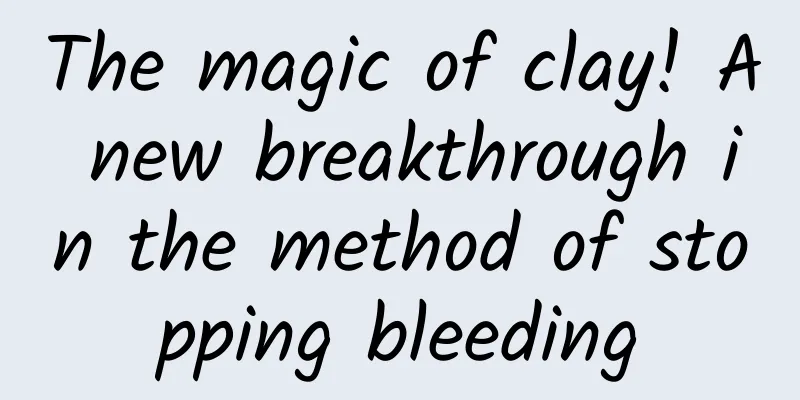The magic of clay! A new breakthrough in the method of stopping bleeding

|
Produced by: Science Popularization China Author: Wang Xiaomei, Wang Aiqin, and Mou Bin (Institute of Chemical Physics, Lanzhou, Chinese Academy of Sciences) Producer: China Science Expo Editor's note: In order to unveil the mystery of scientific work, the China Science Popularization Frontier Science Project launched a series of articles called "Me and My Research", inviting scientists to write articles themselves, share their scientific research experiences, and create a scientific world. Let us follow the explorers at the forefront of science and technology and embark on a journey full of passion, challenges, and surprises. When I was a kid in the countryside, if my finger was cut and bleeding, people would take some soft soil from the country roads and sprinkle it on the wound. As the fine sand fell, the wound miraculously stopped bleeding. It turns out that "soil" can also stop bleeding. So, what is the secret of the “soil” that can stop bleeding? In fact, the principle of "earth" being able to stop bleeding is to use the adsorption and coagulation properties of "earth". "Earth" is usually a mixture of fine sand and clay particles. Among them, clay particles are more sticky and can absorb a lot of water. When "earth" is applied to the wound, the clay particles can absorb the water in the blood and coagulate into lumps, while also adsorbing bacteria and impurities on the surface to prevent infection. Grab a handful of soil (Photo source: veer photo gallery) Today, modern science has proven that the main component of clay in the "soil" that can stop bleeding is silicate clay minerals. The main ones are kaolinite, halloysite and serpentine, whose structural unit layers are 1:1 between silicon-oxygen tetrahedron and aluminum-oxygen octahedron; and montmorillonite, attapulgite, sepiolite, pyrophyllite, illite and vermiculite, whose structural unit layers are 2:1. These clay minerals can form mineral crystals with different structures (layered, layered chain), morphologies (spherical, rod-shaped, fibrous, tubular, lamellar) and dimensions (zero-dimensional, one-dimensional, two-dimensional). The unique nanocrystal structure, permanent structural charge, controllable interlayer domain and special pore structure have been widely used in many fields through different process treatments, structure and surface function regulation. Clay minerals have been used in many applications in hemostasis, but they all have their own shortcomings. In recent years, the research on natural silicate clay minerals in hemostasis has made great progress. Kaolinite can activate coagulation factors through negative charges, and directly promote fibrin formation to accelerate blood coagulation . Therefore, non-woven gauze impregnated with kaolin (the main mineral is kaolinite) (Quick-ClotCombat Gauze®) has become the first choice for hemostatic dressings in the early days. However, it has some shortcomings, such as slow hemostasis rate, need for multiple uses, and poor effect on patients with coagulation disorders. In contrast, montmorillonite easily swells when in contact with water and can cross-link with the effective components in the blood to form a paste-like barrier with strong plasticity and adhesion. At the same time, it activates the coagulation cascade reaction through the negative charge on the surface and accelerates hemostasis. However, montmorillonite granular hemostatic agents can cause local inflammatory reactions and damage to the inner layer of blood vessels, accompanied by the risk of thrombosis of distal organs due to excessive coagulation. Therefore, in recent years, it has been mainly used to construct composite hemostatic materials. In addition, important progress has been made in the research on tubular halloysite and fibrous sepiolite in hemostasis, but the hemostatic properties and mechanisms of clay minerals themselves need to be further studied. Can attapulgite, which has good adsorption properties, be used to stop bleeding? Attapulgite (also known as palygorskite) is a hydrous magnesium-rich aluminum silicate mineral with regular pores (0.37nm×0.64nm) and one-dimensional rod crystal morphology (about 1-5μm long and about 20-70nm in diameter). Due to its unique crystal structure and excellent physical and chemical properties, it has been widely used in adsorption, colloids, carriers and reinforcement, but research on hemostasis is still blank. Morphology and nanopore structure of attapulgite (Image source: Lanzhou Institute of Chemical Physics, Chinese Academy of Sciences) The Mineral Functional Materials Team of the Lanzhou Institute of Chemical Physics, Chinese Academy of Sciences, has long been committed to the functional application research of attapulgite, expanding many new application fields of attapulgite. Since it has a strong adsorption effect, we naturally wonder whether attapulgite can be used to stop bleeding? Attapulgite can form different structures during the geological formation process. Dioctahedral attapulgite has good water absorption performance. Can attapulgite particles quickly absorb water in the blood and condense into blocks? Based on a deep understanding of the microstructure, the team started related research work. Studies have shown that attapulgite has certain hemostatic properties, but compared with clinically used hemostatic materials, its hemostatic efficiency needs to be improved. In order to further increase the water absorption rate, the team used oxalic acid gradient dissolution of attapulgite to increase the specific surface area, pore volume and surface active groups. The study found that attapulgite dissolved in oxalic acid for 1 hour has the best procoagulant effect. To further explore the hemostatic mechanism, the researchers analyzed the physical and chemical properties such as changes in metal ions, surface charge, and hydrophilicity in attapulgite eroded by oxalic acid gradient. The study showed that as the oxalic acid dissolution time increased, the amount of Fe3+ and Mg2+ ions that could be released from the attapulgite skeleton decreased significantly, the surface charge became more negative, and the contact angle decreased significantly and then increased slightly. After 1 hour of dissolution, the trivalent iron ions and divalent magnesium ions required for the hemostasis process were better retained, which was beneficial to accelerate the coagulation reaction. By correlating the changes in the nanopore structure of attapulgite, its hemostatic mechanism is mainly attributed to the nanopores providing support for blood cell adhesion and blood clot formation, excellent water absorption, negative charge activating the endogenous coagulation pathway, and metal ion-assisted coagulation process. Physicochemical properties of acid-etched attapulgite and its hemostatic mechanism (Image source: Lanzhou Institute of Chemical Physics, Chinese Academy of Sciences) One step further! Can mixed-dimensional attapulgite clay be used to stop bleeding? Research to date has shown that various clay minerals have different degrees of hemostatic properties, but with the rapid consumption of high-quality and high-purity clay mineral resources, the high-value utilization of mixed-dimensional clay minerals has received great attention. Different from the high-purity attapulgite formed by volcanic eruption deposition, the attapulgite ore formed by inland saltwater lake phase deposition is mainly composed of one-dimensional attapulgite, accompanied by two-dimensional illite, chlorite, kaolinite and illite-montmorillonite mixed-layer minerals, etc. In order to realize the full mineral utilization, the team defined it as mixed-dimensional attapulgite clay (MDAPT) from the perspective of applied mineralogy and mineral materials science, and the proven resource reserves in Linze, Gansu alone reach 1.35 billion tons. Mixed-dimensional attapulgite clay brings together clay minerals with different degrees of hemostatic properties. So, can its hemostatic effect have a cumulative effect? Based on the differences in the properties of various clay minerals, the team selected mixed-dimensional attapulgite clay, montmorillonite, kaolinite, halloysite and zeolite to conduct a comparative study on the hemostatic properties. The hemostatic properties and hemostatic mechanisms of the materials were systematically studied using indicators such as whole blood dynamic hemoglobin absorbance, coagulation index, plasma dynamics, red blood cell and platelet adhesion and activation, and a mouse tail-cut hemostasis model. The study found that mixed-dimensional attapulgite clay does have the best hemostatic properties. In order to further improve the hemostatic effect, the team also used oxalic acid gradient dissolution of mixed-dimensional attapulgite clay to correlate the structure-activity relationship between clay mineral structure changes and hemostatic performance. On this basis, the team used commercially available products as a control and used a mouse tail-breaking animal model to evaluate the hemostatic performance of acid-etched mixed-dimensional attapulgite clay. The study found that mixed-dimensional attapulgite clay (S-1) treated with oxalic acid for 1 hour had the best coagulation effect. Photos of bleeding and hemostasis experiments in the mouse tail-cut model (Image source: Lanzhou Institute of Chemical Physics, Chinese Academy of Sciences) Since red blood cells play an important role in the hemostasis process, the adhesion ability of biomaterials to red blood cells is used as the main parameter to study its hemostasis mechanism. Platelets are the key component in the thrombosis process. When platelets are activated, granule membrane proteins fuse with platelet membrane proteins, and granule membrane proteins flip to the surface of platelet membranes. Therefore, by studying the adhesion of red blood cells and platelet activation on the surface of mixed-dimensional attapulgite clay, combined with the number and morphology of adhered red blood cells and platelet activation rate, it was further confirmed that S-1 had the best hemostatic performance. SEM images of the interface interaction between mixed-dimensional attapulgite clay and red blood cells and its platelet activation rate (Image source: Lanzhou Institute of Chemical Physics, Chinese Academy of Sciences) Then someone may ask: Since mixed-dimensional attapulgite clay has such good hemostatic properties, is it safe to use it directly? This is also an important issue facing biomaterials as they move from laboratory to clinical application. Preliminary studies have shown that S-1 has good biocompatibility, but subsequent in vivo experimental evaluation from small animals to large animals is essential. Evaluation of biocompatibility of mixed-dimensional attapulgite clay (Image source: Lanzhou Institute of Chemical Physics, Chinese Academy of Sciences) In conclusion, the mixed-dimensional attapulgite clay was dissolved by oxalic acid gradient, and the hemostatic performance was evaluated in vivo and in vitro. It was confirmed that oxalic acid treatment for 1 hour had the best hemostatic effect and good biocompatibility, which opened up a new application path for mixed-dimensional attapulgite clay. However, further research is needed to determine which clay mineral in the mixed-dimensional attapulgite clay mineral has the greatest contribution and comprehensive animal verification experiments. The team will continue to move forward. On this basis, for different wound bleeding, through assembly strategies, we will strive to design multifunctional wound healing materials with different dosage forms to meet the personalized needs of hemostatic materials. |
<<: The reason why the "face plate" has become bigger has been found! (It's not because of obesity)
>>: Counting with sticks, how beautiful is ancient Chinese mathematics?
Recommend
Many people want to play the game of "Pouring water to make ice"! But... Important reminder
"Pouring water to make ice" is a popula...
Immerse yourself in the "rhythm" of the sun! What did the solar exploration satellite "Xihe" discover?
Author: Duan Yuechu and Huang Yanhong The sun, a ...
Xiaoyu Tanqi 2022 [Second Phase] Real-time Trading System Training Camp
Xiaoyu Tanqi 2022 [Second Phase] Real-time Tradin...
Do you often feel pain here and there? Don’t just endure chronic pain anymore. Here are 5 ways to relieve it.
Pain is a warning signal from the body Just like ...
Please fill in the blank: Eat meat but not garlic, ___________
Audit expert: Wang Guoyi Postdoctoral fellow in N...
Drop-down box keyword technology, how to make the Baidu search engine drop-down box?
If your brand word appears when searching for a k...
The latest news on the epidemic: 12 new cases of asymptomatic infection in 31 provinces, autonomous regions and municipalities!
From 0:00 to 24:00 on May 2, 31 provinces (autono...
How to make the most of your Google Ads budget? Share 4 tips!
You can run an advertising campaign even with a d...
The most comprehensive methodology for APP fission and increasing fans!
When talking about this year’s hottest model for ...
Plug-in hybrid vehicles are growing against the market trend and gradually becoming a "blue ocean" in the auto market
Since the release of the "Automotive Industr...
What did the legendary good community do right?
On the evening of June 29, 2016, Qiu Ye, associat...
How to build user stratification operations?
Pyramid stratification is a method of stratifying...
10 questions for brands to start streaming on Douyin
These high-frequency questions almost list all th...
It’s amazing, this “lotus leaf” can actually concentrate light to generate electricity?
Produced by: Science Popularization China Produce...

![Houdini special effects course coordinate special effects [HD quality]](/upload/images/67cc0feab7e3c.webp)







